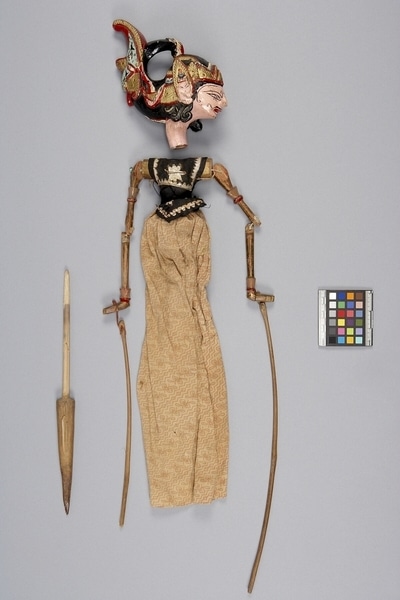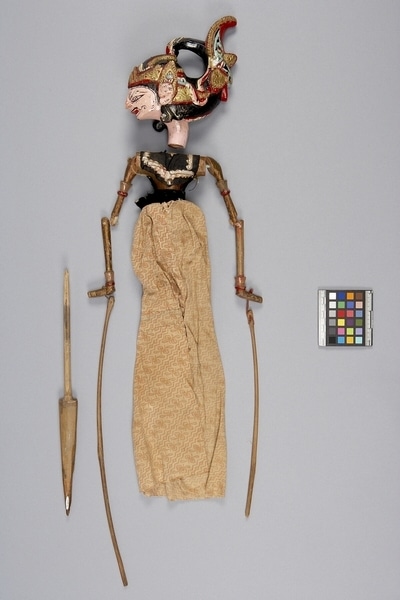Rod Puppet Item Number: Ib344 from the MOA: University of British Columbia


Description
A three-dimensional male humanoid figure puppet. Has a large head and jointed arms attached to controlling rods. The pink face is positioned downwards with red lips and other features outlined in black. Gelung supit urang with Garuda Mungkur (short-tongued), diadem (jamang), lungsen, Tali Garuda (mythical bird) below sumping to jamang, in black, gold, red, green, white, and pink. Arms and hands are painted gold with ornaments at the biceps and at the wrists. The chest is covered by a black garment with opalescent paper sewn on in square pattern having a star-like shape at the centre. Wearing an orange and beige geometrically patterned batik skirt.
History Of Use
Javanese puppetry as an art form probably developed by the 11th century. Wayang golek puppets of western Java appeared during the 16th century. Originally the plays depicted Javanese mythology, but after the Indian conquest of Java the Hindu epics, Ramayana and Mahabharata, were incorporated into the cycles, which comprise about 200 plays. A dalang (puppet master) performs the plays to celebrate important occasions, usually in three acts, with vocal and instrumental accompaniment. Typically they serve a moral and religious purpose, and more recently, one of political commentary. A mood manifestation is a variation on a standard puppet used in situations in which the character is changed, physically or spiritually. They can be actual disguises, depictions of youth or old age (in which lack of wisdom or gained experience is portrayed), or changes in disposition (permanent or not), such as anger, lust, or meditative states. As this character does not correspond to any character exactly, it may be such a manifestation of Narayana (an aspect of Kresna) or Irawan (a raden or prince found in the Mahabharata cycle).
Cultural Context
Theatrical performance.
Iconographic Meaning
Each puppet is characterized by it's wanda, a Javanese word which describes the specific mixture of elements of size, form, colour, ornamentation and carving. Face position, delicate features, headdress all suggest a character of high nobility and refinement. Pink face indicates aggressiveness, assertiveness, or possibly only momentary anger (as in battle). Gelung supit urang, batik skirt, and Garuda found only on characters of rank. Character not identified; possibly a mood manifestation of Narayana, or Irawan.
Item History
- Made in Java, Indonesia
- Owned by Tradewind Antiques before March 15, 1983
- Received from Museum of Anthropology Shop Volunteers (Funding source) and Tradewind Antiques (Seller) on March 15, 1983
What
Who
- Culture
- Sundanese
- Previous Owner
- Tradewind Antiques
- Received from
- Museum of Anthropology Shop Volunteers (Funding source) and Tradewind Antiques (Seller)
Where
- Holding Institution
- MOA: University of British Columbia
- Made in
- Java, Indonesia
When
- Ownership Date
- before March 15, 1983
- Acquisition Date
- on March 15, 1983
Other
- Condition
- fair
- Accession Number
- 0886/0078